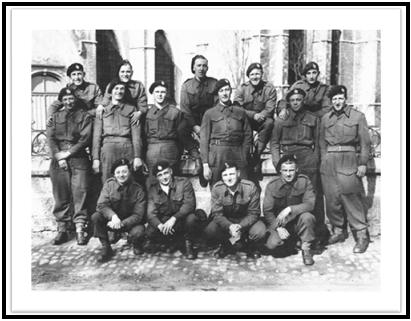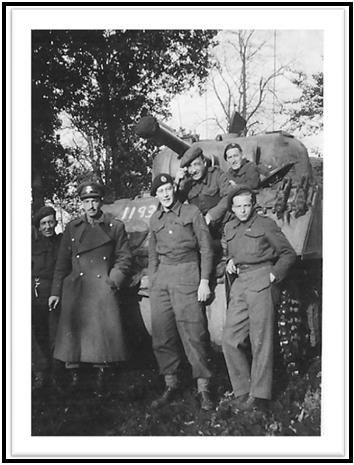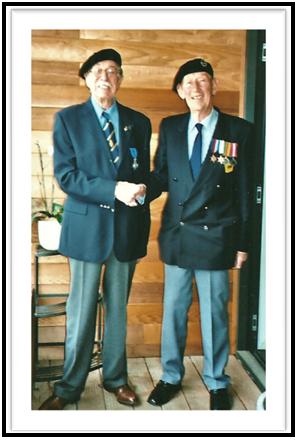Anyone looking for this, will appreciate the update just recieved from our Sherman correspondant, the late Mr Geoffrey Pulzer; a short report from his exploits last year retracing his tracks of 1944; (click here for part 1 and here for part 2), some of that report prefacing the full war report from "Tactical Investigation Directorate War Office, 1944 Dec.H1945 Jan".
Normandy (D.Day+6) to Schleswig-Holstein
in Command of a Tank with a "Wooden Gun"
Firstly, about myself - I was born in London on 6 June 1923. Thus on D-day I celebrated my 21st birthday incarcerated somewhere on the Thames Estuary enduring a total incommunicado black-out , no letters, no phone, no travel.

Cpl. Geoffrey Pulzer with colleagues from HQ 29th Armoured Brigade
I had the privilege of a public school education including a period of army training in the school OTC, a subsequent time with the local (West Hampstead) Home Guard before, when my age permitted, enlisting as a volunteer with the Royal Armoured Corps in December 1941. After training at Bovington Camp, Dorset in early 1942 I was drafted to Brigade H.Q. 29th Armoured Brigade, 11th Armoured Division at Ovingdean near Brighton. I was billeted in a Girls Boarding school (commandeered, of course). An amusing memory was a bell push in the dormitory marked "Press for a Mistress".
The 11th Armoured Division's training in the U.K.. was geared to the prospective role of spearheading a breakthrough following the securement of a bridgehead on the continent and to this end we trained on the South Downs, the Yorkshire Moors (& corn fields), and the woods & flat lands of East Anglia. Eventually waterproofing our tanks in S.England preparatory to D-day.
In 1943 I was promoted to Corporal and given command of a Sherman tank with a wooden gun. This tank was earmarked as a liaison vehicle at the time of battle for the artillery and would be commanded by an artillery officer to observe and communicate to his guns at the rear. This tank had to take on board extra radios for this purpose plus a radio operator. There was no room in the turret for the gun breech so the gun had to go, to be replaced by a wooden replica.
Our journey to Normandy was quite uneventful - the crossing was quite choppy and some seasickness was suffered by others. Our landing craft safely deposited us on the foreshore at Courseulles and we proceeded to our allotted area in the bridgehead around Bayeaux. Some 10 days elapsed before the division was given orders for battle which dramatically ensued with the already documented fighting around Caen. The 29th Armoured Brigade was very badly mauled by the Germans on Hill 112 and my tank was hit on the engine casing by a mortar shell which dislodged the turret and destroyed the radio sets. We in the turret , got away practically unscathed - ringing in the ears, blackened faces and obvious shock is all we suffered - albeit all our bedding and personal possessions were lost. We were able to retreat under our own steam to pick up a replacement tank a week or so later (wooden gun and all!)
Our subsequent "observation" exploits with the forward tanks of the Brigade were quite scary, being so exposed, but at the same time memorable! On one occasion, to draw enemy fire and thus expose their positions, we did a high speed run-around in open country. We didn't draw their fire!

"Ready for battle" - Artillery Officer and his radio operators with myself and driver.
The breakout of our forces through the Falaise Gap is history and the welcome from the French and Belgian populations lining the roads was exhilarating and memorable. My vivid recollection was the enduring smell of Camembert cheese - these were thrown to us but some, unfortunately, were not well aimed and fell irretrievably through the engine vents.
The liberation of Antwerp is the highlight of my campaign. I commanded one of the first tanks to enter this lovely city and after some skirmishes around the park area, the welcome we received was ecstatic but more about its lasting effect later. Our stay in Antwerp was fairly short and the advance towards Germany had to continue. However, in the event, we were bogged down in Holland for the winter and at times it was pretty miserable being stuck along the river Maas in cold, damp and muddy conditions.
Good news reached us in December 1944 that we were going to be re-equipped with new tanks - our Shermans had done us proud all the way from Normandy. The new tank, the Comet was faster, slicker and had fire power. We dumped our old Shermans in a pound in Brussels and proceeded to Poperinge near Ypres (both famous towns in WW1) to train in our new tanks. However within days the Germans had mounted a fierce counter attack in the Ardennes - the BULGE, which the Americans had great difficulty containing. As a back-stop the British agreed to send the 29 Armoured Brigade to the area. In a great flurry of activity and with sleepness nights we dashed back to Brussels, picked up our old Shermans and rushed off to the Ardennes with orders to defend any crossing of the river Meuse. I have a number of particular memories of this Christmas time - it was terribly cold with snow everywhere. I managed to have 3 Christmas dinners at that time - 2 from the American forces and 1 from British army stores.
I had one terrifying experience when we were descending into Dinant, the weather conditions were extreme, the road covered in ice and snow and very steep - our tank started to slide towards the parapet wall and there was a vertical precipice down to the valley below. The heavy tank crashed into the wall and bounced off - what luck!

Relaxing with colleagues
The BULGE was contained , we rejoined the 11th Armoured Division and proceeded to cross the Rhine and fought our way through Germany, by-passing Osnabruck, Minden, Hanover, Hamburg and on to the outskirts of Lubeck in the Baltic. I ended the war in Schleswig-Holstein near Flensburg where we enjoyed some relaxation, good weather and some superb sailing on some nearby lakes.
I ended my army service in London - my mother was an invalid and I was given a compassionate posting to the Pioneer Corps. I lived at home but travelled daily to London to be in charge of a working party decorating Knightsbridge Barracks.
The corollary to this episode of my life is that some years later I met and married a Belgian girl from Antwerp. How come you say? Well I told her how I had liberated her and she fell into my arms! We visit Antwerp from time to time to see her cousin, wife and family - he was a member of the Belgian resistance in Antwerp during the war. Our visits also coincide with the parade and service held annually in Antwerp in early September to celebrate their liberation by the 29th Armoured Brigade . The tank memorial is emblazoned with the divisional motif of TAURUS PERSUANT ("The Bull"), in memory of those in the 29th Armoured Brigade who lost their lives in liberating Antwerp.


Geoffrey Pulzer with Charles Vanhandenhove, (a cousin of his wife) a veteran of the Belgian Resistance